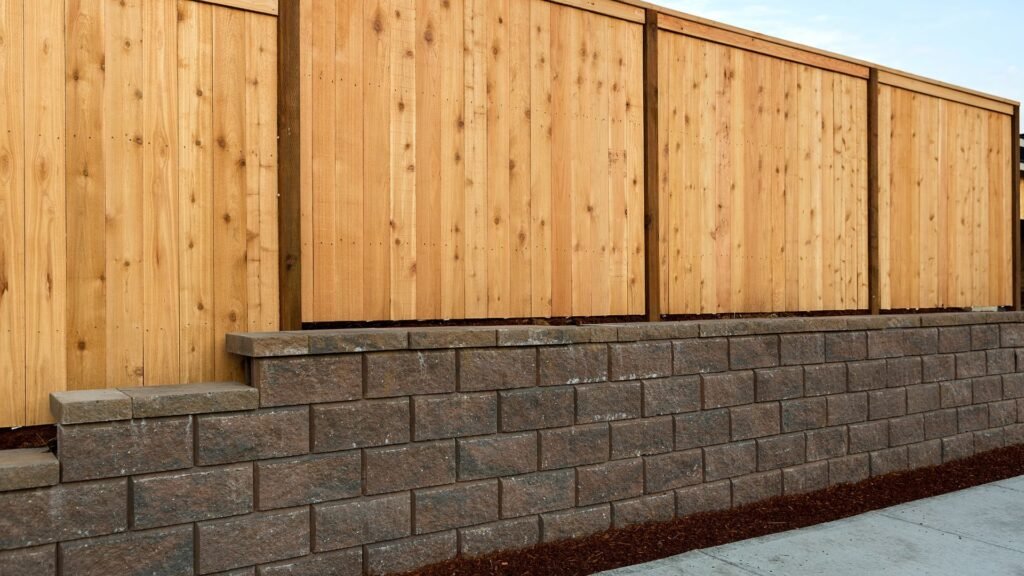Welcome to our guide on innovative design ideas for retaining walls in small gardens across New Zealand—where smart landscaping meets creative style. Whether you’re working with a compact urban courtyard or a sloped backyard in the suburbs, the right retaining wall can do more than just hold back soil—it can transform your outdoor space into a functional and beautiful extension of your home. In this article, we’ll explore clever design solutions, space-saving tips, and material options that suit both your garden size and personal style. From modern minimalist structures to nature-inspired, multi-functional walls, we’re here to help you reimagine your small garden with ideas that are both practical and uniquely Kiwi.
Try space-saving solutions like tiered retaining walls with built-in planters, curved structures for natural flow, or vertical garden walls to maximize greenery in compact spaces. Materials like timber, stone, and gabion add both function and style, while integrated seating or storage can make the most of every metre. These creative approaches are perfect for transforming small New Zealand gardens into functional, beautiful outdoor areas.
Table of Contents
Why Retaining Walls Matter In Small NZ Gardens
In many small New Zealand gardens, especially those found in urban areas, retaining walls are more than just a structural necessity—they’re a smart design feature that blends form and function. Whether you’re dealing with awkward sloped terrain or trying to maximise limited space, retaining walls offer creative solutions that can elevate the look and functionality of your outdoor area.
Aesthetic + Functional Roles
Retaining walls play a dual role in small gardens. On the aesthetic side, they can bring visual structure and design cohesion to a space, framing garden beds, pathways, or feature areas in a stylish way. On the functional side, they serve a vital purpose—supporting soil on sloped sections, managing drainage, and creating flat, usable surfaces in otherwise challenging landscapes. Whether you prefer a natural timber look or a sleek stone finish, the right retaining wall design can seamlessly tie into your garden’s overall style.
Dealing With Sloped Terrain In Urban Kiwi Homes
Many homes across New Zealand, particularly in cities like Wellington and Auckland, are built on hilly or uneven ground. This topography can make landscaping a challenge, especially when working with small backyards. Retaining walls allow homeowners to reclaim sloped areas by creating level terraces that are easier to plant, pave, or use for entertaining. Without them, outdoor spaces can remain underused or difficult to maintain. Well-placed retaining walls turn unusable inclines into valuable garden zones.
Boosting Usable Space And Adding Value To Your Property
Space is at a premium in many New Zealand neighbourhoods, and retaining walls help make the most of what you’ve got. By flattening out uneven ground, you can open up more room for lawns, patios, vegetable beds, or even kids’ play areas. Beyond practicality, these walls can add long-term value to your home. Buyers often look for outdoor spaces that are not only attractive but also functional and easy to care for. A well-designed retaining wall can improve street appeal and signal smart, thoughtful landscaping—something that adds both visual charm and resale value.
In short, retaining walls are a powerful tool for small garden owners in NZ. They solve layout challenges while also enhancing the overall beauty and liveability of outdoor spaces. When carefully planned, they can transform an average yard into a standout feature of your property.
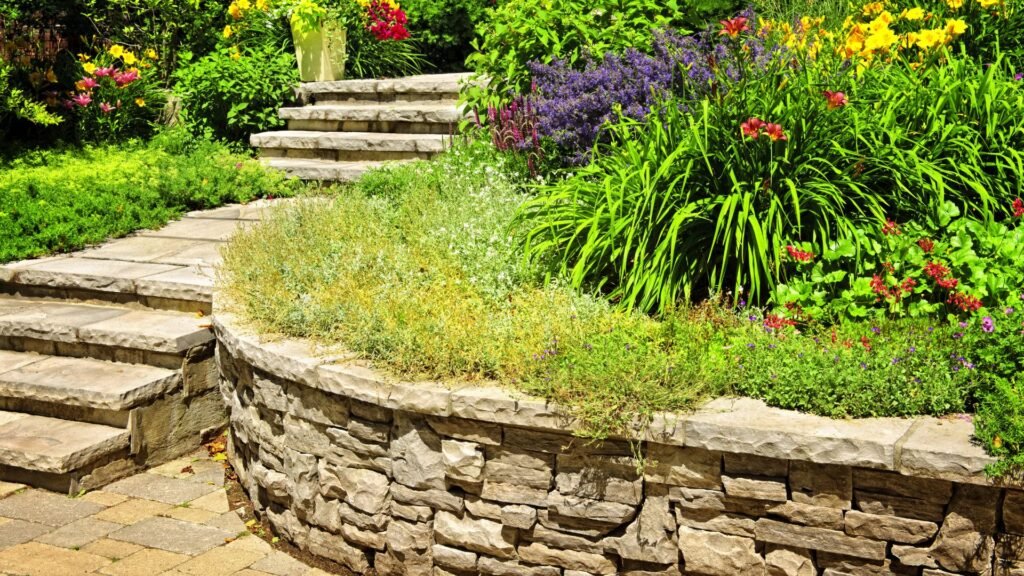
Choosing The Right Materials For Your Style & Budget
When it comes to building a retaining wall in your small New Zealand garden, the materials you choose can make a big difference—not just in terms of budget, but also the overall aesthetic and long-term performance of your wall. From rustic timber to sleek concrete and recycled elements, each option brings its own personality, pros and cons, and level of maintenance. Here’s a breakdown of the most popular retaining wall materials in NZ, along with practical tips to help you make the right choice for your space.
Timber Retaining Walls – Warm, Natural Look For Rustic Gardens
Timber is one of the most common and affordable materials used in small garden retaining walls across New Zealand. Its natural appearance blends beautifully with outdoor spaces, especially in coastal or countryside settings.
Pros:
- Cost-effective and widely available
- Easy to work with, especially for DIY projects
- Natural look suits rustic and native planting themes
Cons:
- Susceptible to rot or insect damage over time
- May require permits if built too high
- Shorter lifespan compared to concrete or stone
Maintenance Tips:
Timber walls should be treated with a wood preservative to help them withstand moisture and pests. Regular checks for signs of rot or warping will help extend their life.
Cost Considerations:
Timber is generally one of the most affordable options, particularly if you’re tackling a smaller wall or DIYing the job. However, consider ongoing maintenance costs when budgeting long-term.
Concrete Blocks & Pavers – Sleek, Modern, Durable
Concrete retaining walls are ideal for modern gardens where clean lines and minimalism are key. Concrete blocks or interlocking pavers are strong, long-lasting, and great for structural support in small but steep NZ gardens.
Pros:
- Extremely durable and weather-resistant
- Clean, modern appearance
- Good for both structural and aesthetic purposes
Cons:
- Can be more expensive to install
- May look too stark in softer, natural garden styles
- Requires professional installation for larger projects
Maintenance Tips:
Concrete is low maintenance. Occasionally check for cracks or signs of settling, especially in areas with heavy rainfall or poor drainage.
Cost Considerations:
Initial costs are higher than timber, but concrete offers better long-term value due to its durability and minimal upkeep needs.
Natural Stone – High-End Appeal, Perfect For Cottage Or Native-Style Gardens
Natural stone brings an earthy elegance to any garden. Whether you’re using schist, river rock, or locally sourced stone, it offers a timeless, organic look that suits many New Zealand landscapes.
Pros:
- Visually striking and full of character
- Extremely durable and long-lasting
- Works beautifully with native plantings
Cons:
- Heavier and more difficult to work with
- Higher upfront cost
- Requires professional installation for best results
Maintenance Tips:
Stone walls require little upkeep. Just keep them free of weeds and debris between stones. If built properly, they can last decades with almost no intervention.
Cost Considerations:
Natural stone is a premium material, and costs can vary widely depending on the type of stone and labour involved. Best suited for those who want a long-term, high-end solution.
Gabion Walls – Trendy, Eco-Friendly, And A Great DIY Option
Gabion walls—wire cages filled with rocks or other materials—have surged in popularity thanks to their modern industrial look and sustainability. They’re especially useful in small gardens that need both style and strength.
Pros:
- Eco-friendly, using recycled or natural fill
- Great for drainage and erosion control
- Visually unique and contemporary
Cons:
- Can rust over time if not properly treated
- May not suit traditional garden styles
- Slightly more effort in sourcing and assembling materials
Maintenance Tips:
Choose galvanized or stainless-steel cages to reduce rusting. Periodically check for sagging or erosion around the base.
Cost Considerations:
Gabion walls are moderately priced, especially if you source your own fill material. They’re also a solid DIY project, saving on labour.
Recycled Materials – Pallets, Corrugated Iron, Or Bricks For A Creative Kiwi Touch
For those who want to get creative while reducing waste, recycled materials offer an affordable and character-filled alternative. From old bricks to corrugated iron or wooden pallets, the possibilities are only limited by your imagination.
Pros:
- Low-cost or even free if repurposing materials
- Unique, creative appearance
- Environmentally friendly choice
Cons:
- Durability can vary depending on the material used
- May not meet structural standards for larger walls
- More suited for decorative or low-load walls
Maintenance Tips:
Treat and seal any wood or metal to prolong life. Be mindful of rust or rot, and reinforce areas that may weaken over time.
Cost Considerations:
This is often the cheapest option—especially if you’re sourcing from salvage yards or using leftover materials from other projects. Just be sure your wall meets safety and building guidelines, especially if it’s supporting weight or soil.
Choosing the right material for your retaining wall is all about balancing function, style, and budget. Whether you lean toward modern concrete or rustic timber, each option offers a chance to enhance your small NZ garden while making smart use of limited space. Take your time, explore your options, and don’t be afraid to mix materials for a truly unique outdoor feature.
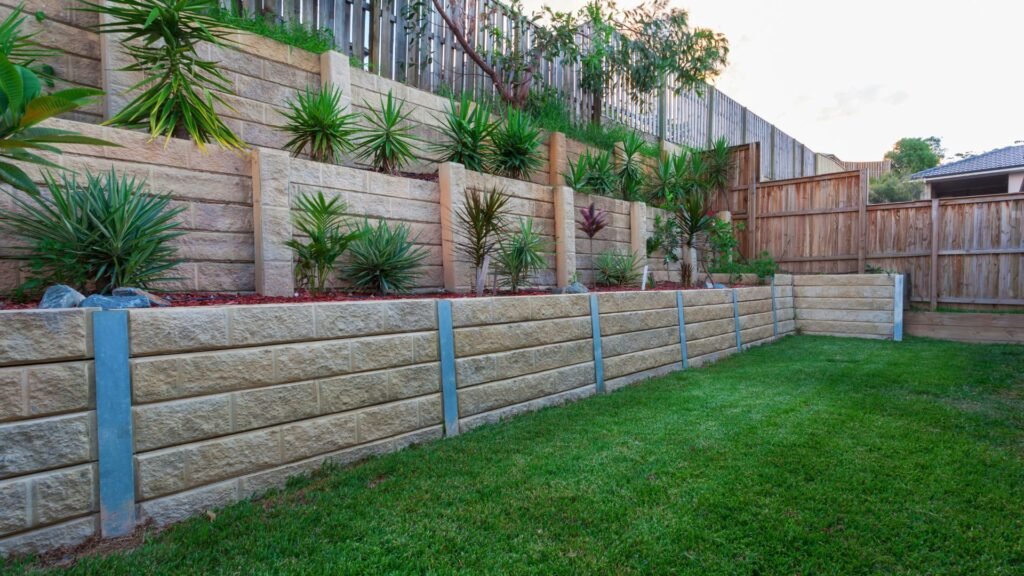
Creative & Space-Saving Design Ideas
When it comes to small gardens in New Zealand, space is at a premium—every square metre counts. That’s why getting creative with your retaining wall design isn’t just about looks; it’s about making your garden more functional, flexible, and enjoyable to spend time in. Below are some innovative design ideas for retaining walls that not only help with structure and support but also add personality, practicality, and style to compact outdoor spaces.
Tiered Retaining Walls With Built-In Planters
Tiered retaining walls are an ideal solution for sloped or uneven landscapes, allowing you to create multiple planting levels without overwhelming the space. These staggered tiers offer depth, texture, and the perfect opportunity to integrate greenery into the structure itself. Built-in planters soften the hardscape with foliage and colour while maximizing vertical space—ideal for herbs, flowers, or even small vegetables.
Quick Tip: Plant low-growing native species like Hebe albicans or Coprosma repens to keep the design low-maintenance and visually cohesive.
Integrated Seating Solutions
Combining a retaining wall with built-in seating is a smart way to get double the function without sacrificing precious garden space. This design is especially useful in smaller yards where traditional furniture might feel bulky or out of place. A timber or concrete bench built into the top of a low retaining wall can define the edges of a patio or fire pit area, offering both structure and a place to relax.
Quick Tip: Use hardwood or treated pine for the seating to match NZ’s outdoor conditions, and consider installing a cushion pad or weatherproof cover for added comfort.
Curved Retaining Walls For Organic Flow
Straight lines can make small gardens feel boxed in, while curved retaining walls introduce a sense of movement and flow. They create soft transitions between levels and can visually expand a space by drawing the eye along a gentle arc. This approach works particularly well in gardens that aim for a naturalistic or cottage-style aesthetic.
Quick Tip: Pair with native grasses like Carex secta or ferns for a lush, soft-edged look that blends seamlessly into your garden design.
Vertical Garden Walls
In tiny garden spaces, going vertical is often the smartest move. Vertical garden walls can be built directly into your retaining wall or added as a panel that attaches to it. These are perfect for herbs, succulents, or trailing natives and can turn a bare wall into a living, breathing feature. It’s an especially useful option for inner-city courtyards where ground-level planting space is limited.
Quick Tip: Choose hardy, drought-tolerant natives like Muehlenbeckia axillaris or Leptinella dioica to reduce maintenance and ensure year-round greenery.
Multi-Use Walls (Storage + Structure)
Think beyond the traditional retaining wall and look for ways to make it work harder. Multi-functional retaining walls can incorporate built-in wood storage, hidden shelving, planter boxes, or even a space for lighting or a BBQ nook. These types of designs are perfect for homeowners who love entertaining or simply want to reduce garden clutter.
Quick Tip: Design with clean lines and natural materials to ensure the wall blends in with the surrounding garden and doesn’t overpower the space.

Smart Design Tips For Small Garden Spaces
Designing a retaining wall for a small garden doesn’t just come down to structure and materials—it’s also about how the space feels, functions, and flows. With limited room, the right design choices can make a small area feel larger, more open, and more inviting. Below are some smart, tried-and-true tips that combine visual tricks with practical considerations, especially relevant to gardens across New Zealand where terrain and drainage can vary widely.
Use Of Colour, Texture, And Contrast
Colour has a powerful impact on how we perceive space. In small gardens, using lighter colours on retaining walls and surrounding surfaces can make the area feel more open and airy. Soft greys, whites, and sandy tones are excellent for creating that sense of space, while also reflecting more light. On the other hand, bold colours—like deep greens, blacks, or terracottas—can add depth and drama when used thoughtfully in accent areas.
Texture also plays a role. Smooth surfaces, such as rendered concrete or polished stone, give a modern, minimalist appearance. Rougher textures, like stacked stone or gabion baskets, create a natural, layered feel. Combining textures—say, a smooth concrete wall with timber seating—adds interest and character without crowding the space.
Contrast is key in defining zones. For instance, pairing dark pavers with a light-coloured wall creates clear boundaries and can help guide the eye across the garden, making it feel more structured and intentional.
Light Vs. Dark Materials (Affect On Space Perception)
The choice between light and dark materials is more than just a style preference—it directly influences how spacious a garden feels. Light materials tend to reflect sunlight, making small spaces appear larger and more open. They work especially well in shaded areas or narrow yards where brightness is limited.
Dark materials, while more visually grounding, can sometimes make a space feel more enclosed. However, when used in contrast with lighter elements—like bright gravel, pale decking, or vibrant plantings—they create a striking and balanced effect. In modern New Zealand garden design, many homeowners opt for a mix: light walls with darker trim or accents to add sophistication without overwhelming the space.
Visual Tricks: Horizontal Lines = Wider Look
One of the simplest design tricks for visually expanding a compact garden is using horizontal lines. Retaining walls with horizontal slats, stacked stone patterns, or wide paver joints help draw the eye outward rather than upward, making the space feel wider than it really is.
This approach is especially effective in narrow side gardens or small urban backyards, where vertical space is limited and horizontal flow helps create the illusion of width. Even plant choices can contribute—low-growing, horizontal-spreading species planted along retaining wall edges help anchor the space and enhance that expansive feel.
Drainage And Waterflow In NZ Gardens (Important But Easy To Digest)
While it may not be the most exciting design element, good drainage is essential—especially in New Zealand, where rainfall can vary significantly depending on the region. Without proper drainage, even the most beautiful retaining wall can become a structural issue over time.
Incorporating basic drainage solutions into the design doesn’t have to be complicated. Behind the retaining wall, include gravel backfill and perforated drainage pipes (also called ag pipes) to guide water away. Make sure the wall includes weep holes to allow water to escape, preventing pressure buildup. For sloped or clay-heavy sites, a professional consultation is often worth it to avoid future headaches.
If you’re planning a DIY retaining wall, be sure to research your specific site conditions—or consult your local garden centre or landscape supplier for region-specific advice. It’s one of those “get it right the first time” steps that will keep your garden looking great and functioning well long-term.
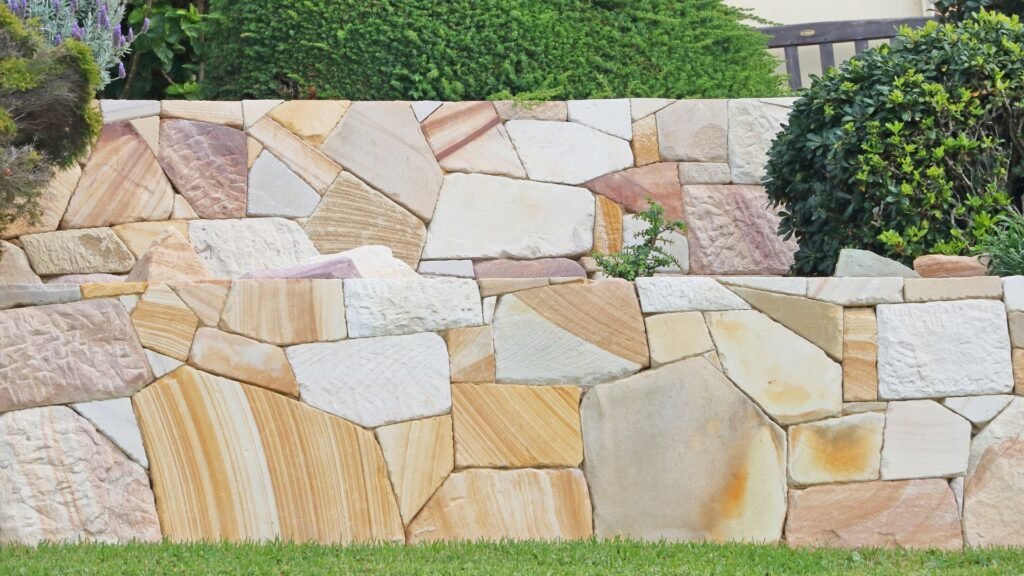
DIY Vs. Hiring A Professional
When A DIY Approach Works: Low Walls, Basic Builds
Tackling a retaining wall project yourself can be a rewarding experience—especially for homeowners who enjoy hands-on outdoor work and want to save on labour costs. DIY is usually a smart option when you’re building a low retaining wall, typically under one metre in height, and the site is relatively flat and easy to access. These smaller builds are often less complex, which means fewer structural or safety concerns. Using timber or modular concrete blocks can make the process more manageable for first-timers, especially if you’re following a reliable step-by-step guide.
Before you begin, it’s essential to plan carefully. Proper drainage, stable footing, and good-quality materials are key to a long-lasting wall. Many New Zealand garden projects have been successfully completed with a bit of Kiwi ingenuity and basic DIY skills—just be sure to do your homework and use level-checking tools to ensure stability and straightness.
When To Bring In The Pros: Height, Council Consents, Complex Terrain
While smaller projects might be DIY-friendly, there are certain situations where calling in a professional is not only advisable—it’s necessary. If your retaining wall is over 1.5 metres tall, built on a slope, or located near property boundaries, the project may require council approval, engineering input, or geotechnical reports. This is especially true in areas of New Zealand with challenging terrain, heavy rainfall, or unstable soil conditions.
Hiring a professional landscaper or builder also ensures compliance with local building codes and safety standards. Professionals have the right tools, experience, and understanding of materials and drainage systems. They can also navigate any permit requirements and help you avoid costly mistakes that may arise from a DIY misstep. When in doubt, it’s worth investing in expert advice, even if only for the design or structural planning phase.
Tips For Finding Reputable Landscapers In NZ
Choosing the right contractor can make all the difference in the outcome of your retaining wall project. Start by looking for landscapers or builders with proven experience in retaining wall construction, especially in your local area. Ask to see a portfolio of past projects, and don’t hesitate to request references from previous clients.
Check for memberships with industry associations such as Registered Master Landscapers NZ, which can be a sign of professionalism and accountability. Online reviews, social media presence, and word-of-mouth recommendations are also great ways to gauge a landscaper’s reputation. Always get multiple quotes, and make sure they include clear timelines, cost breakdowns, and terms of service. Communication is key—choose someone who is transparent, responsive, and open to collaborating on your vision.
Estimated Costs For Popular Styles: Rough Guide
The cost of building a retaining wall in New Zealand can vary significantly based on materials, size, location, and whether you go the DIY route or hire a professional. For a basic timber wall under one metre tall, DIY costs might range from $150 to $300 per metre, depending on the quality of timber and whether you already have the necessary tools.
Professionally built walls, especially those over one metre or using premium materials like natural stone, can range from $400 to $900 per metre or more. Gabion walls and modular concrete block walls tend to fall somewhere in the middle, offering durability and design flexibility at a moderate price point.
Don’t forget to factor in costs for excavation, drainage systems, and permits where required. While DIY might save you on labour, professionals often provide longer-lasting results and peace of mind—especially for complex or large-scale projects.
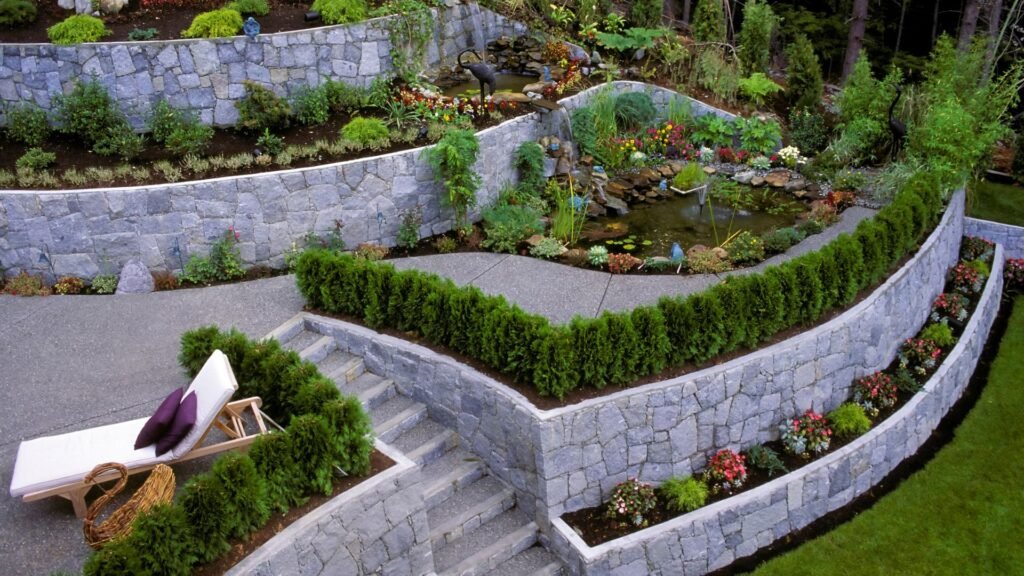
Eco-Friendly And Low-Maintenance Options
When designing retaining walls for small gardens in New Zealand, it’s not just about aesthetics and structure—eco-friendliness and low maintenance can also play a major role in long-term value and sustainability. With more homeowners becoming environmentally conscious, it’s important to consider how your retaining wall design can support the local ecosystem while reducing ongoing upkeep.
Sustainable Materials
Choosing sustainable building materials is one of the most effective ways to reduce your garden’s environmental footprint. Opting for reclaimed timber, recycled concrete, or natural stone sourced locally can significantly cut down on the energy and emissions involved in transportation and processing. Gabion walls—wire cages filled with stones or recycled material—are another great option that combines functionality with sustainability. These materials not only last for years but also blend seamlessly into natural landscapes, making them ideal for New Zealand’s unique garden settings.
Water-Smart Design Features
A well-designed retaining wall should do more than hold back soil—it should help manage water efficiently. Incorporating water-smart features like swales, weep holes, or built-in drainage systems behind the wall helps prevent waterlogging and reduces the risk of erosion. This is especially important in regions across New Zealand that experience heavy rainfall. Permeable materials such as gravel, crushed stone, or porous pavers can also improve drainage, making your garden healthier and easier to maintain without relying on excessive irrigation.
Native Planting Tips That Work Well With Wall Design
One of the most rewarding ways to make your retaining wall both eco-friendly and low-maintenance is by integrating native plants into your garden design. Species like Hebes, Flax (Harakeke), Griselinia, and Carex are well-suited to New Zealand’s climate and require minimal watering and fertilisation. These plants are naturally adapted to local soil and weather conditions, which means they thrive with less intervention—saving you time, effort, and resources. You can plant them in built-in wall planters, pockets in gabion walls, or at the base to soften the look of the structure while supporting local biodiversity.
Incorporating native vegetation also attracts beneficial insects and birds, further enriching your outdoor space. Plus, the combination of sturdy wall materials with soft, flowing plant life creates a beautiful contrast that feels natural and intentional.
Discover more inspiring ideas, quality materials, and expert advice over at Retaining Walls Wellington — your local partner in smart, stylish landscaping solutions across New Zealand.

FAQs: About Innovative Design Ideas For Retaining Walls In Small Gardens In NZ
What are the best materials for retaining walls in small NZ gardens?
Popular materials include timber for a natural look, concrete blocks for a modern finish, natural stone for premium appeal, and gabion baskets for a trendy, eco-friendly option. Your choice depends on style, budget, and the space available.
Do I need council consent to build a retaining wall in New Zealand?
In many cases, retaining walls under 1.5 metres tall that aren’t supporting a building or driveway may not need consent. However, it’s essential to check with your local council as rules vary by region.
How can I make a retaining wall more space-efficient?
Consider multi-functional designs like walls with built-in seating, vertical planters, or storage spaces. Curved and tiered walls can also help maximize limited space while adding visual interest.
What is the most cost-effective retaining wall option?
Timber is typically the most budget-friendly, especially for DIY builds. Recycled materials like pallets or old bricks can also lower costs while adding character.
Can I build a retaining wall myself, or should I hire a professional?
For low, simple walls (usually under 1 metre), DIY is possible with the right tools and planning. For taller walls or those needing engineering support, hiring a professional is recommended to ensure safety and compliance.
What plants work well with retaining walls in New Zealand gardens?
Native plants like Hebes, Griselinia, and Carex are ideal for low-maintenance, attractive greenery. For vertical walls, consider herbs, succulents, or trailing plants like Dichondra.
How do I maintain a retaining wall long-term?
Regularly check for drainage issues, cracks, or signs of wear. Timber walls may need treating or staining over time, while concrete or stone walls typically require less maintenance.
Are retaining walls good for preventing erosion?
Yes, retaining walls are a practical solution for stabilising sloped areas and preventing soil erosion, especially in regions with heavy rainfall or uneven terrain.
Can I add lighting to my retaining wall?
Absolutely! Integrated LED strip lighting, solar lights, or spotlights can enhance both safety and aesthetics, particularly if the wall doubles as a seating or pathway feature.
How can retaining walls improve the value of my property?
Well-designed retaining walls enhance curb appeal, increase usable garden space, and offer practical benefits like drainage and erosion control—all of which can boost property value.
Conclusion
Creating a beautiful and functional garden doesn’t require a large space—just the right ideas and a touch of creativity. In this guide, we’ve explored a range of innovative design ideas for retaining walls in small gardens across New Zealand, from space-saving tiered structures and vertical gardens to materials that suit every style and budget. Whether you’re dealing with a sloped backyard or simply want to make the most of a tight space, the right retaining wall can transform your garden into a practical, stylish retreat. Remember, even the smallest outdoor area holds the potential for something special. So take inspiration from the ideas shared here, and don’t be afraid to get creative with your design. What’s your favourite retaining wall idea? Let us know in the comments or share a photo of your garden project—we’d love to see how you’ve brought your space to life.

